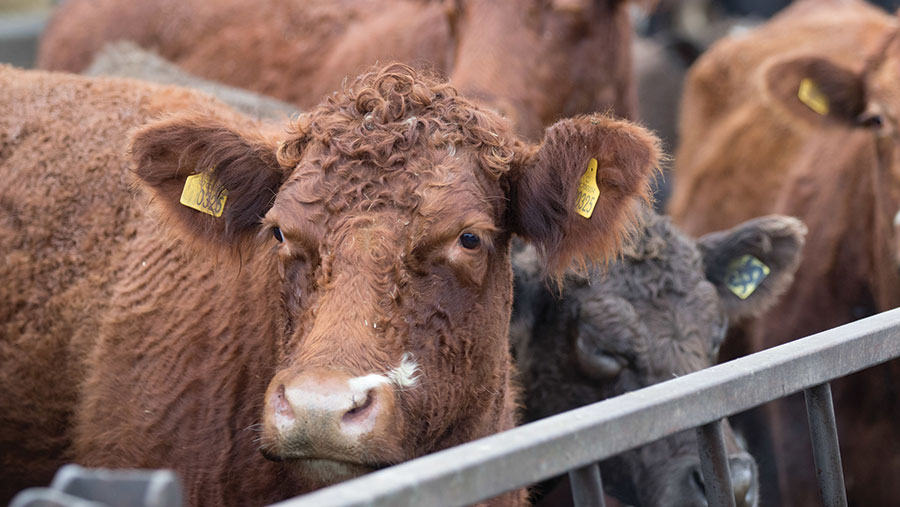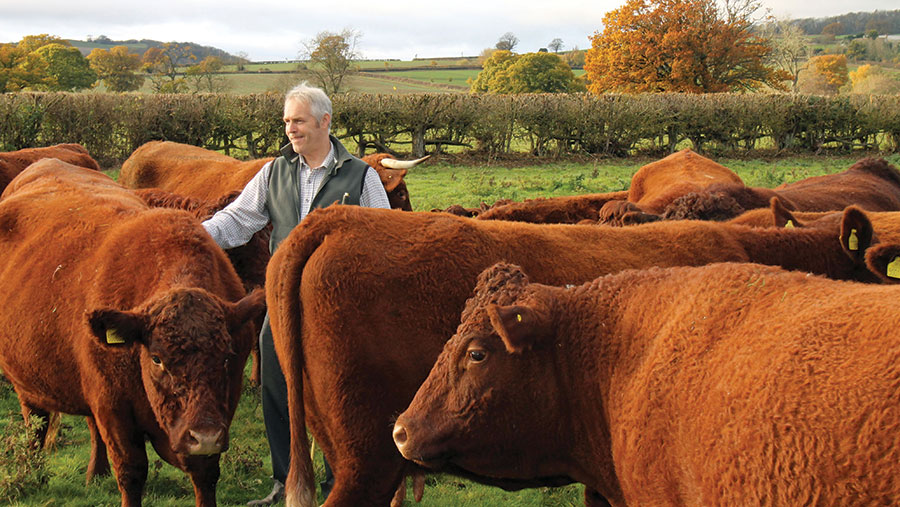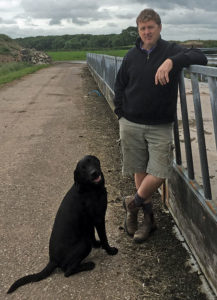Beef – should I stay or should I go?
 © Tim Scrivener
© Tim Scrivener Before opting to stay in or quit beef production, farmers should take a rigorous, structured-approach to the decision-making process, say advisers.
Much of the long-term uncertainty felt by beef producers is due to the question mark hanging over support payments beyond 2020 and Brexit, says AHDB Beef & Lamb strategy director Laura Ryan.
The UK government has pledged to keep the status quo with support payments until then but longer term support is uncertain.
AHDB surveys show that among beef farms in England, about 17% will be unable to survive without subsidies. About 53% will find their businesses in financial distress, Ms Ryan says.
See the other “Should I stay or should I go?” articles
Added to this, despite rising global demand for beef and improving prices this spring, there are ongoing concerns over beef price volatility and unknowns over access to markets once the UK leaves Europe.
Whatever the future holds, the best advice is for farms to review the financial and physical performance of their businesses to identify strengths and weaknesses before making any decision about change.
Ms Ryan adds the key points in making a decision are to:
- Assess the market
- Evaluate business performance
- Consider opportunities and risks
Assess the market
Knowing what the market is doing and gleaning as much information about possible short- and long-term price movements is vital to ensure a business is best positioned, says Ms Ryan.
The external forces at play should be carefully considered in any long-term decision on the business’ direction.
UK beef trade
- 75% self-sufficient in beef
- Imports 250,000t/year or 35% of consumption
- Ireland supplies 68% of imports
- UK exports 100,000–120,000t/year (15-17% of production)
- Export value about £330m/year
- More than 90% of UK beef exports go to EU
- Offal exports at 48,000t/year (2015) double 2009 level
Short term price snapshot
A bullish spring cattle trade driven by shorter supplies saw the GB all prime average up by 30-40p on year-earlier figures from April.
The week ended 5 August saw the all steers average at 370.2p/kg dw, up 30p on the same week of 2016, while heifers averaged 374.9p/kg compared with 342.2p in early August last year.
R4L animals were making 10-15p/kg more than the overall averages, this premium having grown by a few p/kg since spring and with heifers gaining more over the average than steers.
Abattoir data shows about 53% of beef carcasses are failing to hit spec.
Missing grading targets is a significant factor in profitability, says Scotland’s Rural College (SRUC) beef team leader Gavin Hill.
“The stricter enforcement of weight limits for cattle sold deadweight and penalties for missing specifications are seeing a lot of potential profit wasted,” he says.
“But prices are only half the story, as input costs remain high on most farms,” says Mr Hill. While the fall in the value of sterling after the Brexit referendum improved export potential, it also saw feed prices rise.
That means the average upland suckler unit continues to lose about £1.10/kg deadweight.
“Net margins clearly indicate that many in the beef Industry are struggling to find profitability in the short term, forcing them to rethink,” he says.
Medium term
Defra figures show the total beef breeding herd has remained relatively stable, rising by 1.5% from 710,000 in the 2014 June census to 721,000 head in June 2016.
However, consultant Andersons’ Outlook for 2017 predicts a sharp fall in beef cattle numbers of up to 8%, which would firm up prices.
Tighter supplies provide a more optimistic price outlook, says Andersons’ consultant Ben Burton.
The effect of last year’s EU referendum results was weaker sterling, increasing exports by 5% in value, to about £330m, while Irish imports fell by 5,000t to 44,400t in the three months after the vote.
But there is a note of caution for home-grown native cattle, with about 20,000 more aged 12-24 months coming through the system.
AHDB senior analyst Duncan Wyatt says: “There is a marked native beef breed premium but the increase in supply of these cattle is putting that under pressure.
“It is worth considering that for the long-term the two peaks may converge as the native breed premium is eroded by supply,” he says.
Longer term
The biggest uncertainties and potential changes clouding long-term strategy planning are linked to Brexit trade negotiations – warnings of further price volatility in the coming years are commonplace.
NFU chief livestock adviser John Royle says: “With Brexit looming, it is a challenging time for all farmers and everyone is faced with difficult decisions regarding their business. As we know, this is a long-term business and farmers are making decisions now that will be key for their farm in two years’ time.
“If a trade deal isn’t resolved then we could see imported product becoming more expensive, leading to stronger demand for UK-produced beef.”
But there are several possible outcomes to consider.
If the UK government successfully negotiates free access to the EU market little will change in buying and selling.
However, other trade talk outcomes complicate the picture. A free-trade agreement (FTA) would provide tariff-free trade but controls on capital and labour movement. This may affect labour availability and increase fixed costs.
If FTA negotiations fail, World Trade Organization (WTO) rules would apply. This would leave UK beef facing the same hefty tariffs on exports to Europe as to other non-EU countries.
For beef that is 12.8% plus a fixed cost of up €3,041/t (£2,660/t). This would add about 50% to UK export costs, hitting competitiveness.
Other countries also have import tariffs such as China which imposes 12-25% on beef imports.
Evaluating performance
To get the business into the best position, whether it is to stay in the sector or leave, it is imperative to first know exactly where it stands, says AHDB senior analyst Carol Davis.
Accurate financial and physical records must be produced and analysed carefully before any decision is taken, Ms Davis advises.
The records should cover all aspects of physical performance from breeding dates, pregnancy to calving, rearing and replacement rates.
“The starting point is weighing stock frequently to identify any performance flat-spots that can point to poor quality feed or forage, or sub-clinical disease,” she says.
Once there are accurate physical performance records it is possible to start apportioning costs to calculate a cost of production figure for £/kg deadweight.
All costs – fixed and variable – and not just cash only, must be included, Ms Davis warns.
Figures for a rental equivalent for owned land, depreciation, paid and unpaid labour, must always be accounted for.
Another important reason to establish and attribute both variable and fixed costs is cashflow.
“Where there are regular overheads such as paid labour or loan repayments then cashflow has to match those items. One of the biggest reasons for business failure is inadequate cashflow to cover regular costs.”
With all costs accounted for these can be compared with data from other farms using online benchmarking tools available through the AHDB in England and Quality Meat Scotland for producers north of the border.
For example, the AHDB’s whole-farm benchmarking system, Farmbench, allows the producer to compare their own business with the bottom, middle and top performing producers from 400 farms on the database. The system feeds into the annual AHDB Stocktake benchmarking reports.
Data can also be plugged in to the AHDB’s Assessing Business website spreadsheet. The system can be used to run a report that can be cross-referred with other benchmark farms.
The Stocktake report shows that top-third farms earn 55pp/kg deadweight more than the bottom tier.
That difference is maintained through to the gross margin stage after relatively similar variable costs across all tiers are attributed.
It is after fixed costs, including imputed values as Ms Davis suggests, that the difference between the tiers rises to more than £2/kg deadweight (see Stocktake table, below).
AHDB Stocktake report for combined/breeder finisher unit £/kg dwt) |
|||
|
Bottom third |
Middle third |
Top third |
|
|
Output |
3.51 |
3.74
|
4.06
|
|
Total variable costs |
1.50 |
1.46 |
1.35 |
|
Gross margin |
1.78 |
2.11 |
2.59 |
|
Cash net margin (includes cash only fixed costs) |
-0.10 |
0.56 |
1.26 |
|
Full investment net margin (includes imputed depreciation, finance costs, unpaid labour and rental equivalent) |
-2.12 |
-0.69 |
-0.05 |
Top third producers achieve their position through
- Higher growth rates
- Higher sale weights
- Higher price/head
- Lower concentrate use
- Using more home-grown forage
- Better quality forage
- Lower fixed costs
- Lower labour input
- Better genetics
Source: AHDB
Consider opportunities and risks
With the market influences understood and the business position carefully evaluated, the range of options for the business can be assessed from a more informed and robust position.
Options to consider
- Getting more from the existing set up
- Scale-up or scale-down
- Let land or contract farm
- Change marketing system
- Breed change, added value
- Switch to a different agricultural sector
- Diversify
- Quit farming altogether – ie retire, retrain
Getting more out of the existing business
The first step before quitting or changing anything is to examine whether the existing business could be made more profitable, says AHDB senior analyst Duncan Wyatt.
For example, spot market volatility may be avoided through fixed-price contracts – this is one of a range of options, although not necessarily for a producer’s whole output.
Fine-tuning sale weights to hit spec and going for an outlet with higher rewards is another. In contrast, it may be better to find an outlet which has fewer discounts.
Other tweaks may be possible with more rigorous health and breeding management to cut calf mortality and vet bills. Producing better quality forage, and using more grazing input if possible is another route for some.
Scaling down
Reducing the size of the operation can be for lifestyle or management reasons, says SRUC’s Gavin Hill.
If the farm is making a loss, downsizing can allow the enterprise to match the labour requirement more closely with the operation to reduce fixed costs.
But Mr Hill warns that margins can be eroded by reducing cattle numbers. It means there is not the output the following year and often overhead costs such as machinery, buildings and labour are not reduced sufficiently to improve margins.
Scaling-up
Increasing numbers may work for some but it is more important to think in terms of profit rather than scale and minimising overheads.
People think increasing cow numbers will spread costs yet variables such as feed increase in-line with herd size while additional fixed costs such as building investment and labour can put the business under pressure, warns AHDB senior analyst Carol Davis.
Diversifying
The best diversifications improve cashflow, reduce volatility and add profit while complementing the existing set up, says Ms Davis.
However, new business ventures can turn out to be a distraction – timewise and financially – from the expertise of the core business, in this case producing beef, so it may be better to concentrate on what you know.
Lifestyle – letting land, contract farming agreements
Farming can be very stressful which may be a reason to quit. But there could be an opportunity to bring other family members in to alleviate some of the pressure through a partnership agreement.
This could potentially allow one partner to stand back from daily management while retaining active involvement a status that must be achieved to secure income and inheritance tax benefits.
It is advisable to include a third party to ensure partnerships, wills and agreements are legally watertight.
Quitting legal and tax considerations
Owning farmland is a tax-efficient use of capital and selling-up could incur capital gains tax. It is also beneficial to maintain active farmer status for inheritance tax purposes.
Other possible liabilities should also be considered, such as the tax bill from a sale of assets or interest charges and indemnity penalties on ending long term loans, before making any decision.
Case study: Stay

Rob Alderson
Shropshire farmer and regional NFU livestock representative Rob Alderson has decided to stay in beef production by developing a three-pronged strategy – niche marketing, finishing cattle and selling stores.
A 10-year battle with bovine TB forced Mr Alderson to rethink the business structure on his 175ha (430-acre) beef, sheep and arable unit – Upper Walton Farm, Onibury, near Ludlow.
The disease hit the farm in 2002 and saw the suckler herd cut back from 240 cattle to about 70 head.
“It had a profound impact and, as the beef price went through peaks and troughs, we increased sheep numbers and arable rather than rebuilding the herd,” he says.
Now though, driven in part by his passion for beef production, Mr Alderson is increasing cattle numbers again and has adopted three approaches to marketing including the purchase of a pedigree herd.
In all, there are about 100 commercial crossbred – Charolais, Aberdeen Angus, Limousins and Simmental cattle all put to a Limousin stock bull.
These have been divided into two production streams – finishing and stores – according to weights and conformation.
“To avoid penalties you have to get weights bang on for the retailers now so finishing takes more time and I can’t justify investing in more labour.
“So I have decided to split the commercial herd with the lighter Simmental crosses taken to finishing weights up to 675kg off grass and our own milled ration,” he explains.
“The more shapely Limousin stock will be sold as stores at 450kg to a specialist finisher who has more time to get them to the exacting specifications and maximise their value.”
The biggest change is the acquisition of a small pedigree herd of 36 Ruby Red Devon cattle which Mr Alderson likes for their docility and ease of management.
He has now established the Tadmore prefix and the first calves were born this spring.
As a distinctive native breed the Ruby Red has more appeal with local outlets which he hopes will produce a premium over commercial cattle.
Mr Alderson has an agreement with a local abattoir and butcher just five miles from the farm who appreciate the assurance of close traceability to pass on to their customers.
Recognising the butcher is a limited outlet, he is also approaching new customers and has been negotiating to sell into a restaurant chain in neighbouring Staffordshire.
Case study: Go

David Prince
A straightforward financial decision to quit beef production was made tougher by the associated redundancies of two highly skilled staff, says Nottinghamshire farmer David Prince.
Mr Prince’s Wood Farm, near Lambley, has developed from a 58ha (143-acre) family unit into a larger contract farming and tenanted business covering 600ha (1,480 acres) of sugar beet, cereals and maize for AD.
Until March 2016 the farm also ran 750 mainly Aberdeen Angus cattle on a 120-day finishing system across two units.
These were finished on maize and grass silage from leys in the arable rotation at 450kg liveweight to achieve a 330kg carcass for a retailer contract.
But additional feed was needed and competition with the renewable energy market for maize was pushing up ration costs, explains Mr Prince.
“In the first six months of 2015 we saw margins/kg become negative and with the numbers of stock involved that quickly became a situation requiring action,” he says.
Because the farm is situated in a bovine TB Edge Area Mr Prince first considered setting up two Approved Finishing Units to take animals from restricted herds.
But a price of £70,000 for robust fencing to keep out wildlife could not be justified.
Reducing numbers was also not an option because the fixed costs associated with the enterprise would not have diminished by the same scale.
With the pattern of loss likely to repeat in 2016, and with TB spreading ever closer, the decision was taken to end beef production entirely.
“It was the right business decision but making redundant two highly- skilled workers was extremely tough,” he says.
The unit has now been operating for a year without beef and the 750sq m (8,000sq ft) of cattle housing has been switched to storage, serving customers from nearby Nottingham.
With a twist of irony, the 42ha (103 acres) of maize is now sold on to the AD market which had previously been the major competitor for the crop and a driver for rising beef ration costs.
“If you can’t beat them, join them,” says Mr Prince.
